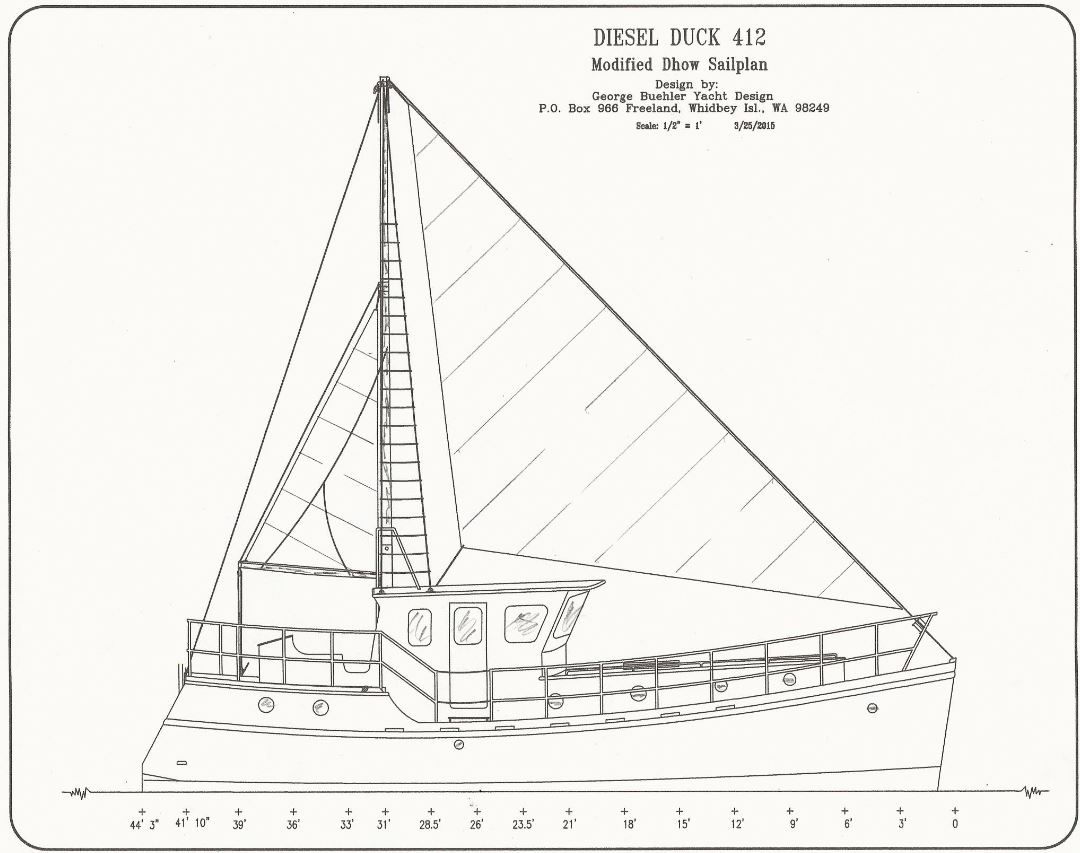
This new DUCK steel design is a “fine tuned” version of the 41-Plus, which in its own right is successful. That “plus” and “2” stuff refers to the “sugar scoop” style transom the boats have, which makes the boat a bit over 44′ on the water but 41′ on deck, making a built in “swim step” that makes boarding from a skiff easier than climbing over the side. It’s awkward to build in wood though, so wood versions have a recessed stairway down to a heavy bolt on swim step.
There’s two differences between this boat and the original 41-Plus. This boat is narrower, 13′ 3″ plus rub rails, so at most will be 13′ 7″ wide. This could make a difference in trucking; for example, it could make sense to truck it across the “lower 48”, between San Diego and the Gulf of Mexico rather than run clear around. The other difference is the pilothouse is 3′ further aft on this boat. While this reduces the size of the owner’s cabin it does open up the main cabin more. To further take advantage of this, the interior drawing shows an option with the galley in the main cabin. Some people think the galley back in the passageway is constricting, and keeps the “kitchen help” from being part of the party.




Construction is typical heavy steel “DUCK.” I think the “sugar scoop” stern makes wood impractical although you could do it I suppose. In that case I’d suggest a normal transom with a recessed stairway down to a heavy swim step.

The sail plan is my “Modified Dhow” idea I’ve written about elsewhere. What’s new here is the “main” (the sail aft of the mast) has been really reduced in size and is now just a “handkerchief” mean to be left up all the time. I’ve gone to this because it appears almost all DUCK owners have permanent covers over the cockpit, which makes handling a normal main very difficult. This little sail, cut flat and built heavy, will just live always up. You see this on a few west coast trollers and I remember seeing it on Maine lobster boats. It makes sense.
Is the mast to far aft to support “flopper stoppers”? I don’t think so. I also don’t think there’s a need for floppers when you have the small main up except maybe in the case of big swells and no wind, a not unusual but still not common situation. But even here the sail reduces rolling except it flaps loudly which can be annoying. But we’re talking boats, not motor homes, and you can’t have everything peaceful ALL the time!
This aft position of the mast allows a big and very low aspect headsail to be used. Owners of a 44 DUCK currently in the Med say they use this big head sail all the time. It greatly reduces roll and helps fuel economy. They never bother with their paravanes which I why I suggest not installing them. The sail makes them unneeded.

Here’s the 44 mentioned above, using the “Modified Dhow” rig.
I have been pretty close to these designs for a long time and believe it or not, it’s hard for me to write about them! The internet has so changed the way we can find information and if you’re interested in the Diesel Duck concept I invite you to do a web search on them. You’ll see all sorts of postings ranging from bitchy criticism to friendly reviews. Like everything else on the net, take it all with a grain of salt!
| LOA: ………. 44.25 ft LWL:………. 43.27 ft Beam:……….. 3.25 ft Beam WL: …12.98 ft Draft:…………. 5.67 ft Displ at DWL… 61812.41 lb. |